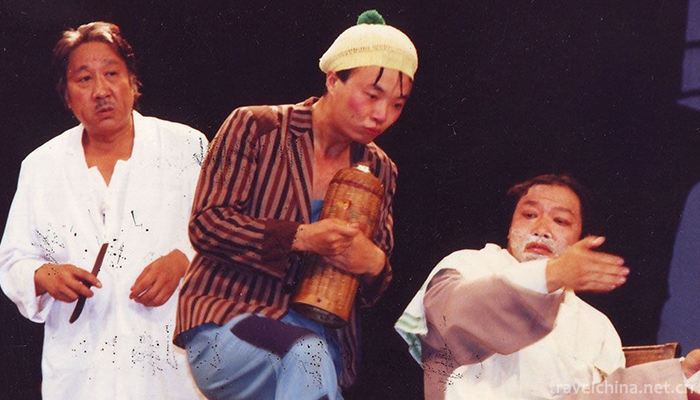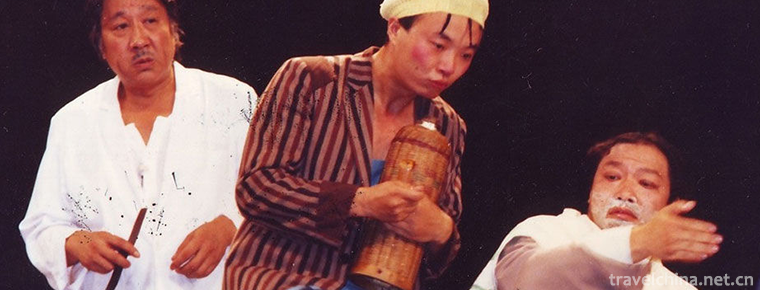One Man show
One Man show
A kind of folk art. It is usually performed by one or two or three people. It is lively and funny, close to northern crosstalk. It is popular in Shanghai, Hangzhou and other places.
One-legged opera is a new kind of traditional opera. It is popular in Shanghai, Jiangsu (southern Jiangsu) and Zhejiang, performing in Wu dialect. Single-legged opera rose around 1920. In its early stage, it was performed by one person. It was artistically influenced by such popular rap forms as "Little Hot Dusk", "Singing News" and "Next-door Opera" in Jiangsu, Zhejiang and Shanghai.
In 2008, it was selected as the second batch of national intangible cultural heritage list.
Name source
One-legged opera, also known as funny, originated in Shanghai during the Republic of China and is popular in Shanghai, Zhejiang and southern Jiangsu.
Local traditional folk arts in the region. Because the actor played many roles at first, he was called a one-man play. In Shanghai dialect, the pronunciation of "jia" and "go" is different. At this time, the one-legged play is still a one-legged play, until the word is passed to the north. In the middle part of Putonghua, the character is homophonic with the character, so "role" is used, and "one-legged play" is used as "one-legged play".
Some people here wonder, shouldn't the character read jue? In fact, the original sound of the character is jiaose. In the early days, different pronunciations were used in all walks of life in Beijing to express the characteristic vocabulary of the industry (the old Beijingers called it "bad pronunciation"), such as coral, tiger, amber and amber in antique circles. At that time, the industry characteristic character character of the opera industry was pronounced as "ju" color. People in the industry said "I am a ju" when they met people. The origin of the Ju pronunciation can be traced back to the early period of integration of Beijing dialect and Central Plains Mandarin, which brought about the second reading of Chinese and vernacular, the second reading of Jiang Dian and the third reading of Zheng Dian, yqin/uo from Nanjing Mandarin, and ijiu/Zhengu from North. Beijing Mandarin finally developed into Jue sound. In the later stage of the development of the opera industry, the influence became more and more strong, so people succumbed to the concept of "jue" color, including the current dictionary changed to "jue" sound.
"One-legged play" is the original word, then "one-legged play". Similarly, the original word of the role is "role".
Historical origin
origin
Around the ninth year of the Republic of China (1920), when Wang Wuneng, an artist of Shanghai Civilized Drama, was unable to perform in the hall, he played many roles by telling jokes, telling stories, singing Peking Opera and learning dialects. In the 16 years of the Republic of China, Wang Wuneng officially performed as a "one-legged play". In the same year, Jiang Xiaoxiao of Hangzhou came to Shanghai, called "social comedy". The next year, Liu Chunshan came up one after another, called "fashion comedy". Three people are unique in the rise of one-legged drama, and later generations are called "three funny people".
Develop to its peak
In the 18th year of the Republic of China, Shanghai New World Recreation Center invited the famous five classes (10 people) of the time to hold weekly "congress series" in the name of "Wufu Troupe", which expanded the influence of the one-legged play. In the 1930s, the one-legged play was in its heyday. There were more than 100 performers in the entertainment hall, auditorium and private radio stations. They all made their own performances and showed their abilities. During the War of Resistance Against Japan, many one-legged actors took part in propaganda activities. In the 31 years of the Republic of China, Jiang Xiaoxiao initiated the formation of a comedy troupe. Most of the one-legged entertainers began to play comedy at the same time.
New comic
From the victory of the Anti-Japanese War to the early days of the founding of the People's Republic of China, Yao Mushuang and Zhou Baichun appeared as "new comedy" and typhoon was bookish. While inheriting and developing the songs of their predecessors, they compiled a large number of new passages, such as "The People Are Happy". Cheng Xiaofei set up a new school in singing, displaying various local operas in one-legged operas. Yang Huasheng returned to Shanghai from the Mainland, performing a one-legged play focusing on the content of the work. At that time, Yao, Zhou Jiu, Cheng, Liu (Xiao Liu Chunshan), Yu (Xiangming), Yang, Zhang (Qiaonong), Xiao (Xie Xie), Shen (Yile) were exhibitors on folk radio, and they had a large audience. Artists traveled all over the radio, playgrounds, halls, dance halls and restaurants, once again setting off the climax of one-legged play. In the early days of the founding of the People's Republic, there were more than 500 one-legged actors. Since then, most single-legged actors have participated in the theatre troupe mainly to perform comedy. The performances of one-legged plays usually appear in the "one-legged theatre special" organized by special organizations, or in funny broadcasts, or in the rural grass-roots units of the factory to perform a complete set or sporadic programs.
Great Development of "Singing" School
From the early 1950s to the early 1960s, the singing school of one-legged opera developed greatly. Many one-legged performers often use the name "say" or "rap and sing" to talk and sing new things on the radio or to broadcast programs of the "singing" School of one-legged drama. Some amateur actors, represented by Huang Yongsheng, carried forward the tradition of singing current affairs and news in the one-legged opera "Singing in the School", and renamed "Shanghai Rap" around 1964. Although there were some singers specializing in Shanghai rap and singing at this time, there was no interruption in the performance featuring "singing" in the one-legged play. They sang more new things on the radio, such as Zhou Bochun, Yang Huasheng, Yuan Yiling, Tian Lili, Shen Yile, Wu Shuangyi, Wang Shuangqing, Tong Shuangchun and Zhang Yadi. They played the part of the singing of the one-legged play until the "Cultural Revolution". Start.
Comic Troupe Restoration
Since 1978, some comedy troupes specializing in and concurrently performing one-legged operas have gradually resumed their establishment. They are: Shanghai Opera Troupe (later renamed as Shanghai Comedy Troupe), Shanghai Radio and Television Art Troupe, Shanghai People's Comedy Troupe and Shanghai Qingyi Comedy Troupe. Many young and middle-aged actors stirred up the big beams of one-legged performances, including Wu Shuangyi, Tong Shuangchun, Wang Shuangqing, Weng Shuangjie, Li Qing, Xiao Shengmi, Sun Ming, Fang Yanhua, Guo Mingmin, Liu Fusheng, Yao Qier, Yao Yonger, Shen Shaoting and Cai Jianying. The people's comedy troupe has enriched a large number of amateur actors, among whom Wang Rugang is the best. Shanghai Funny Opera Troupe started a school to train Comedians in 1981. New comedians include Qian Cheng, Hu Jingyun and Qin Lei. One-legged opera has entered another new period of development.
Accession
In 2008, one-legged opera was listed in the second batch of national intangible cultural heritage list .


-
1.The Beijing Palace Museum
The Beijing Palace Museum was established on October 10, 1925, and is located in the Forbidden City of the Beijing Palace Museum. Based on the palaces of Ming and Qing dynasties
Time 2018-11-24 -
2.Yungang Grottoes
Yungang Grottoes is located in the southern foot of Wuzhou Mountain, 17 kilometers west of Datong City, Shanxi Province, northern China.
Time 2018-11-24 -
3.Shanghai Baoshan International Folk Art Exhibition Hall
Shanghai Baoshan International Folk Art Exhibition Hall is the first exhibition, research and protection of intangible cultural heritage in Shanghai constructed by Shanghai University in cooperation w
Time 2018-12-19 -
4.Guanyin Gorge Scenic Area
Guanyinxia scenic spot is the entrance of Yulong Pass, one of the six major parks of Lijiang Bazi. It is located at the "Yulong Pass" of the three major parks of Lijiang Bazi and is known as
Time 2019-01-13 -
5.Guangxi Medicinal Herb Garden
Guangxi Medicinal Botanical Garden is located in Xiangzhu Avenue, Nanning City, Guangxi Zhuang Autonomous Region. It was founded in 1959 and covers an area of 202 hectares
Time 2019-01-13 -
6.Red Flag Canal Scenic Area
Red Flag Canal Scenic Area is a national AAAAA class scenic area, covering an area of five square kilometers. Red Flag Canal Scenic Area is composed of Red Flag
Time 2019-01-16 -
7.Huashan pictographs
Huashan rock paintings are located in the Zuojiang River and its tributary Mingjiang River valley of Chongzuo City, Guangxi (covering Ningming County, Longzhou County, Jiangzhou District and Fusui Cou
Time 2019-01-17 -
8.Zhoucun Ancient Mall
Zhoucun Ancient Mall, also known as Street, is located in Zhoucun District, Zibo City, Shandong Province. The main road of Shandong Province, Jiqing Expressway
Time 2019-03-20 -
9.Lv Opera
Lv Opera, also known as masqueraded Yangqin and Qinxi Opera, National intangible cultural heritage, one of the eight major Chinese operas, Shandong's most representative local operas, is popular in mo
Time 2019-05-15 -
10.Tujia Year
Tujia Year is an important and ancient festival of Tujia people in Xiangxi Tujia and Miao Autonomous Prefecture of Hunan Province. During the thousands of years of historical development, some relativ
Time 2019-06-23 -
11.Chinese history
Chinese history From China Chinese civilization To the present history. China has a long history. Since the Huangdi tribe Ji Xuanyuan (also known as the Gong sun Xuanyuan) period has been counted for
Time 2019-08-28 -
12.Dazhous location
Dazhou is located in the junction of Sichuan, Chongqing, Hubei and Shaanxi provinces and the Chengdu Chongqing Economic Belt in the upper reaches of the Yangtze River. It is the "East Gate" of Sichuan opening to the outside world and a key regi
Time 2020-12-20